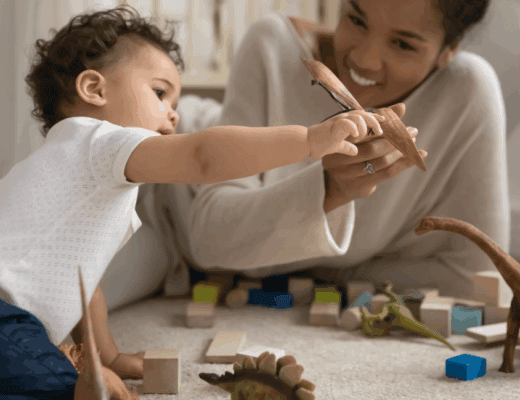Manipulatives for toddlers aren’t just about fancy toys with buttons and lights—they’re about hands-on exploration that builds a strong foundation for future growth and development.
From fine motor development to early math and problem-solving skills, manipulatives help young children learn through unstructured, self-directed play!
And the best part? You probably already have dozens of them lying around your home. I’m here to share all my favorite simple manipulatives to get you started.
In this post
- What Are Manipulatives?
- Why Are Manipulatives Important for Toddlers?
- Everyday Items That Make Great Toddler Manipulatives
- Best Toys That Serve as Manipulatives for Toddlers
- Easy Manipulative Activities to Try Today
- Safety Tips for Toddler Manipulatives
We get commissions for purchases made through links in this post. As an Amazon Associate, we earn from qualifying purchases.
What Are Manipulatives?
Manipulatives are objects that kids can touch, move, and manipulate with their hands to explore concepts like sorting, building, patterning, sequencing, and imaginative play.
For toddlers (ages 1–3), manipulatives should be:
- Safe and non-chokable
- Sized for little hands
- Open-ended and engaging
- Designed to encourage fine motor skills, hand-eye coordination, and cognitive development
Manipulatives don’t teach through screens or lectures. They teach through touching, trying, testing, and tinkering. Through repeated hands-on experiences, toddlers begin to understand how the world works and build the brain pathways needed for more complex thinking later on.
Manipulative play supports independent learning, nurtures curiosity, and fosters creativity in a very tangible way.
Why Are Manipulatives Important for Toddlers?
Manipulatives are essential for early development.
Here’s what’s happening when a toddler plays with manipulatives:
- Fine Motor Practice: Pinching, grasping, stacking, and scooping strengthen finger muscles essential for tasks like holding a crayon, using scissors, or buttoning clothes.
- Cognitive Skills: Toddlers begin to understand cause and effect, spatial relationships, and early math concepts like size, quantity, comparison, and classification.
- Problem-Solving: They experiment with how things fit together, balance, or work. When something doesn’t go as planned, they try again, building perseverance and flexibility.
- Language Development: As you narrate and describe the play (“You stacked three blocks!” or “That lid is too big for the cup”), children build vocabulary and comprehension.
- Concentration and Independence: Manipulative play invites toddlers to slow down, focus, and engage in purposeful work, often extending their attention spans naturally. Learning to follow their interests and direct their own time is a much-needed life skill for kids!
Over time, these skills translate into stronger academic readiness, more confident self-help abilities, and a deeper love of learning.
Everyday Items That Make Great Toddler Manipulatives
You don’t have to spend a dime to build a manipulatives collection! These household items offer incredible opportunities for learning, fine motor work, and creative play:
• Kitchen Tools
Your kitchen is a treasure trove of manipulatives. Items like measuring cups, spoons, muffin tins, ice cube trays, silicone cupcake liners, and small bowls can all be used in a toddler’s play.
Try this: Set up a sensory bin with dry beans or rice (or a sensory bin filler of your choosing) and provide a variety of scooping tools.
Toddlers will explore transferring, pouring, and measuring. You can even add color-coded spoons and cups for sorting and matching practice.
• Laundry & Clothing
Socks, clothespins, and buttons may seem mundane, but they offer excellent fine motor challenges.
Try this: Create a simple matching activity with clean socks or colored baby mittens. Toddlers can sort and roll them into balls. Clothespins clipped to a basket edge are great for building finger strength.
Loose Parts
Loose parts are open-ended objects that can be moved, carried, combined, or taken apart.
- Check out my post on Loose Parts Play or download my FREE complete guide! 👇
Examples include: Large jar lids, poker chips, cardboard shapes, pipe cleaners, plastic rings, or even sturdy bottle caps.
Try this: Let toddlers poke pipe cleaners through the holes of a colander or thread them through a whisk. It’s simple, satisfying, and develops coordination and problem-solving.
Recyclables
Your recycling bin is full of potential! Caps, boxes, bottles, and containers all make great manipulatives.
Try this: Use egg cartons to sort colored pom-poms or dry cereal. Yogurt cups become stackers. Cardboard tubes can be used for rolling marbles or building towers. The possibilities are endless when you’re willing to reuse with creativity.
Best Toys That Serve as Manipulatives for Toddlers
While everyday items are incredibly valuable, a few well-made toys can provide extended engagement and developmental benefits.
Here are some of my favorites.
1. Learning Resources Mini Motors Counting and Sorting Set
I absolutely love using math counters as a toddler manipulative!
The various colors and types of vehicles encourage sorting and classification while still being open-ended enough to allow for creative play. Simply place them out, step back, and see all the creative ways kids use them.

Add a set of colored bowls to further encourage sorting. They also pair well with blocks, animal toys, or dumped in a sensory bin.
2. Melissa and Doug Lacing Beads
Beads are an excellent manipulative for small hands!
I really love the oversized beads in this Melissa and Doug set and love that the set itself contains a minimal number of pieces – nothing worse than a million-piece set that slowly gets lost all throughout the house!
3. Wooden Shape Sorting Puzzles
Puzzle pieces are an excellent manipulative for toddlers and help build their persistence, visual-spatial awareness, and problem-solving skills.
I love that this set also incorporates a shape sorting aspect.
Protip: only have out ONE puzzle at a time! This allows toddlers to build mastery with a single shape and keeps a million pieces from being dumped all over the floor.
4. DMOIU Magnetic Building Blocks
These magnetic blocks are perfect for little builders!
I love that the open-ended nature of the shapes allows for lots of creativity and self-direction. Opt for a larger set whenever possible to increase the build possibilities.
5. Wooden Toddler Light Up Switch Board
This board is an ABSOLUTE toddler favorite! I have watched little ones explore the switches for hours. Pressing, turning, and toggling the switches turns on each of the lights on the board.
Not only does it build fine motor skills, but it also promotes perseverance, problem solving, and cause and effect as kids learn how to operate each switch.
6. Excellerations Pop Beads
Here is a set of super fun beads that snap together. They are great for building dexterity and encouraging toddlers to use both hands cooperatively.
The size of the beads is perfect for small hands while being large enough not to pose a choking hazard.
7. Wooden Loose Parts
A set of wooden loose parts makes the perfect manipulatives for toddlers! The simple, open-ended pieces allow for lots of creativity and pair well with block sets, sensory bins, and many other toys.
Make sure to supervise your toddler, especially if they like to put toys in their mouth.
Easy Manipulative Activities to Try Today
Looking for ways to use manipulatives right now?
These toddler-friendly activities are simple to set up and big on developmental value:
1. Pom-Pom Push
Materials: Container with lid (cut holes into the top), pom-poms
How to Play: Toddlers push pom-poms through the holes using fingers or tools. This activity is incredibly satisfying and strengthens precision and concentration.
2. Scoop & Transfer Station
Materials: Bowls, dry materials (beans, rice, pasta), scoops, tongs, spoons
How to Play: Set out various tools and containers and let your child scoop and transfer. Step back and let them explore the materials without interruption.
3. DIY Coin Slot Box
Materials: Recycled plastic jar (something like a large mayonnaise jar works well), poker chips or wooden play coins
How to Play: Cut a slit in the lid of the jar. Toddlers drop the chips through the slot, building coordination and cause-and-effect understanding.
4. Playdough & Tools
Materials: Playdough, buttons, sticks, rolling pins, cookie cutters, pipe cleaners, etc.
- Here’s my favorite playdough recipe that you can easily make at home!
How to Play: Toddlers squish, roll, and poke objects into the dough. This is sensory play meets fine motor gold.
5. Sorting Tray
Materials: Muffin tin, colored items (pom-poms, lids, blocks, buttons)
How to Play: Invite your toddler to sort by color, size, or type. Sorting boosts early math skills and observation.
Safety Tips for Toddler Manipulatives
Here are a few tips to help keep manipulatives safe and fun for toddlers.
- Supervise play, especially with small or household items.
- Choose age-appropriate materials that are too large to swallow.
- Check for wear and tear on homemade manipulatives regularly.
- Rotate toys and objects to keep interest high.
- Store materials accessibly, so toddlers can choose and clean up independently (with help).
Final Thoughts
Manipulatives for toddlers don’t have to be expensive or complicated. With just a few well-chosen toys—and some clever repurposing of everyday objects—you can offer your toddler endless learning opportunities right at home.
Remember: The goal isn’t perfection—it’s participation. Let your child explore, repeat, and delight in the joy of hands-on play.











No Comments